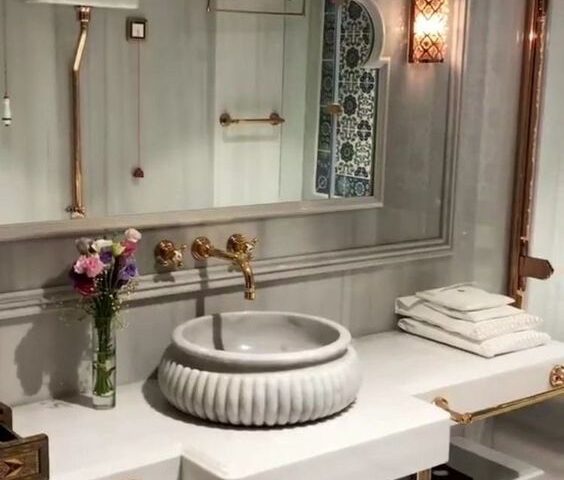Thinking of using stone in your project? This guide includes popular types of natural rock used in architecture, interiors and design with links to hundreds of examples to inspire your own work.
Alabaster
Alabaster is a soft, fine-grained stone that has been used for centuries to carve elaborate forms and ornaments. However, its solubility in water means that it is best suited for indoor use.
In its pure form, alabaster is white and translucent, which makes it ideally suited to lighting design.
Basalt
Basalt is a dark-coloured igneous rock that is formed when lava cools rapidly. It is most frequently used as an aggregate for concrete as it is low-cost and high-strength, but it is also a popular cladding and flooring material, especially when polished.
Gneiss
Gneiss, a robust metamorphic stone composed of alternating layers of different coloured minerals, is popular to use for flooring and worktops. Hues can range from pinks and golds to greens and dark greys.
Granite
Granite is one of the most widely used stones in architecture and design. It forms from the slow crystallization of magma beneath the Earth’s crust. It is used for everything from load-bearing structures to cladding, worktops and furniture.
Its popularity is down to its high compressive strength, durability and low porosity. Granite is also found in an array of colors, making it suitable for a range of spaces and styles.
Laterite
Rusty-red laterite stone is formed from the leaching of rocks and soil during alternating periods of high temperature and heavy rainfall in tropical areas. This process leaves behind a high concentration of insoluble iron oxides, which gives the rock its color.
Laterite is typically used in construction in Africa and Asia in the form of bricks, which have excellent thermal mass and a low embodied energy. These bricks are made by cutting the rock out from below the water table when it is moist and leaving it to harden in the air.
Limestone
There are many different types of limestone, a sedimentary rock composed mainly of calcium carbonate. It is considered a good all-round building material as it is easy to cut and carve and usually has a uniform texture and color.
Marble
Marble is a metamorphic rock with veins of calcite crystal. It forms from limestone that has been exposed to heat and pressure and is found in many colors. Marble is strong but easily carved and polishes well, making it suitable for numerous applications.
Onyx
Onyx is a translucent gemstone composed of parallel bands of quartz, found in almost every colour. It has a long history of use in sculpture and jewelry but is less commonly found in architecture and design. However, onyx is sometimes used as a facing or lighting.
Porphyry
Porphyry is a strong and hard-wearing igneous stone that comes in reddish-brown to purple hues. It is composed of large-grained crystals embedded in a fine-grained groundmass.
It has been used in architecture and design since antiquity, though it is rarely seen in contemporary architecture and design. Today it is mostly used as aggregate in the construction of roads in places where cars require studded winter tires.
Quartzite
Formed from sandstone exposed to high heat and pressure, quartzite is a very hard and durable metamorphic rock. It is usually found in white and grey shades.
Quartzite is a popular material for kitchen countertops as it is resistant to staining, but is most commonly used as a decorative cladding or flooring.
Sandstone
Sandstone is composed of fine silicate grains that have eroded from other rocks, giving it either a warm red, yellow or orange coloration.
Used for construction since prehistoric times, sandstone continues to be a popular choice in architecture and design as it is abundant, durable and easy to handle.
Shale
This grey fine-grained stone is one of the most common sedimentary rocks on earth. It is formed from the compaction of silt and mud into thin, fissile layers. In architecture and design, shale is usually crushed and processed into bricks, tiles and pottery, or heated with limestone to make cement.
Slate
Slate is a dark fine-grained stone that is formed when a sedimentary rock, such as shale, is subjected to high pressure. It is a foliated rock, meaning it is made up of thin sedimentary layers, which allows it to be split – or riven – into thin slabs.
Slate is durable and weather- and frost-resistant, making it a popular material choice for cladding, roofing and paving.
In interior projects, the material is often also used as floor tiles, hearths and kitchen worktops.
Travertine
One of the most commonly used forms of limestone is travertine, which has been sourced from mineral springs for use as a building material for centuries. The largest building in the world made from this stone is the Colosseum in Rome.
Today, travertine is mostly processed into tiles for internal and external surface coverings, but it is also a popular material for bathroom fit-outs. As it is found with troughs on its surface, processing travertine usually involves polishing its surface.
















